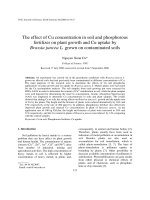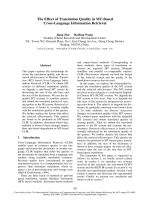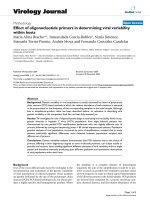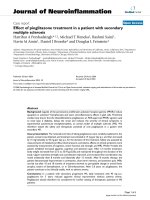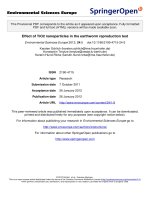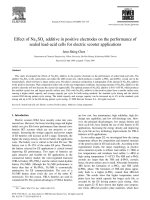Effect of phosphorus and zinc solubilizing acidifiers on content and uptake of micro nutrients in summer soybean
Bạn đang xem bản rút gọn của tài liệu. Xem và tải ngay bản đầy đủ của tài liệu tại đây (191.65 KB, 8 trang )
Int.J.Curr.Microbiol.App.Sci (2017) 6(6): 2784-2791
International Journal of Current Microbiology and Applied Sciences
ISSN: 2319-7706 Volume 6 Number 6 (2017) pp. 2784-2791
Journal homepage:
Original Research Article
/>
Effect of Phosphorus and Zinc Solubilizing Acidifiers on Content and Uptake
of Micro nutrients in Summer Soybean
B. Kranthi Kumar*, Syed Ismail, K. Manasa and K. Anuradha Pawar
Department of Soil Science and Agricultural Chemistry, Vasantrao Naik Marathwada Krishi
Vidyapeeth, Parbhani 431 402, Maharashtra, India
*Corresponding author
ABSTRACT
Keywords
Soybean,
Nutrient content,
Nutrient uptake.
Article Info
Accepted:
26 May 2017
Available Online:
10 June 2017
The present investigation was carried out during summer season of 2014-15
on Research farm, Department of Soil Science and Agricultural Chemistry,
Vasantrao Naik Marathwada Krishi Vidyapeeth, Parbhani to evaluate the
effect of different zinc solubilizing microbial cultures on nutrient content
and uptake of soybean grown on Vertisol. Results revealed that highest
Nutrient content and uptake was increased with the inoculation of microbial
cultures as compared to uninoculated control and highest Fe, Mn, Cu, and
Zn uptake was found with the treatment RDF + Rhizobium + Trichoderma
viride.
Introduction
Soybean (Glycine max L. Merrill) a grain
legume is considered as a wonder crop due to
its dual qualities viz., high protein (40-43%)
and oil content (20%). It also contains 60%
poly-unsaturated fatty acid, vitamin-B (300
I.U) and vitamin C, D, E, K. It contains
0.69% phosphorus, 0.011% iron, 0.024%
calcium and all other essential amino acids
(Rahman, 1982). Major soybean growing
states in India are Maharashtra, Madhya
Pradesh, Gujarat and Rajasthan. India ranks
5th in area and production of soybean in the
world after U.S.A., Brazil, China, Argentina.
Soybean has emerged as one of the major oil
seed crop in India with the coverage of above
108.8 lakh hectare with estimated production
of over 104.36 lakh MT during 2014. In
Maharashtra state, soybean crop is grown on
an area of 38.08 lakh hectare with total
production 30.72 lakh MT with average
productivity of 808 kg/ ha (Anonymous,
2014). The poor productivity of soybean is
mainly due to imbalance application of
nutrients and use of traditional varieties.
Under such situations, use of Rhizobium and
zinc solubilizing bacteria (ZSB) had shown
advantage in enhancing soybean productivity.
Microbial inoculants are cost effective, ecofriendly and renewable sources of plant
nutrients. Zinc has an immense role in
nutrition of both eukaryotic and prokaryotic
organisms as cofactor or metal activator in
various enzyme systems (Hughes and Poole,
1989). Bacteria are known to immobilize
metal by precipitation and adsorption. The
ability to dissolve immobilized zinc viz. zinc
2784
Int.J.Curr.Microbiol.App.Sci (2017) 6(6): 2784-2791
phosphate, zinc oxide and zinc carbonate in
appreciable quantity is not common feature
amongst the cultivable bacteria on soil
surface. Few Zn solubilizing bacterial genera
viz. Thiobacillus thioxidans, Thiobacillus
ferroxidans,
Acinetobacter,
Bacillus,
Gluconacetobacter,
Pseudomonas
and
facultative thermophilic iron oxidizers have
been reported as zinc solubilizers (Saravanan
et al., 2007). Because of avoidance of
environmental problems, human health, and
more crop integrated nutrient management
plant beneficial living microbial cultures
(biofertilizers) are supposed to be a safe
supplement to chemical fertilizers in order to
minimize the ecological disturbance. A
number of microorganisms are considered as
challenging agents for agriculture to promote
better nutrient uptake and availability for
plant use particularly zinc mobilizing and
acidifying cultures may help to increase the
zinc and other micronutrients availability for
the crops like soybean. Summer soybean has
a tremendous potential to be used as seed for
kharif season. By considering these points,
experiment was carried out to study the effect
of zinc solubilizing microbial cultures on
yield, nutrient uptake and quality of soybean.
Materials and Methods
Field experiment was conducted at research
farm of Department of Soil Science and
Agricultural Chemistry, Vasantrao Naik
Marathwada Krishi Vidyapeeth, Parbhani on
Vertisol during summer season of 2014-15 on
soybean variety MAUS-162. The initial soil
pH was 7.96, EC- 0.28 dSm-1, organic
carbon-5.26 g kg-1, CaCO3 - 37.0 g kg-1
available N - 190 kg ha-1, P2 O5 - 16.7 kg ha1, K2 O - 580 kg ha-1 and S-9.42 mg kg-1.
The initial micronutrient status were available
Cu 2.27 mg kg-1, Mn 7.22 mg kg-1, Zn 0.56
mg kg-1, Fe 5.28 mg kg-1.The soil was
clayey in texture, low in organic carbon,
available nitrogen, medium in phosphorus,
sufficient in potassium and low in sulphur. As
among the micronutrient status Cu, Fe and
Mn were above the critical limits but
Available Zn content in experimental soil was
found to be deficient. The treatments
comprising inoculation with liquid inoculants
of BradyRhizobium and Bacillus megaterium
(PSB) for soybean, used in alone and in
combinations. The experiment was laid out in
Randomised Block Design with eight
treatments in combinations in three
replications. The experiment consisting of 8
treatments of laboratory tested Zn solubilizers
T1: RDF + Rhizobium; T2: RDF + Rhizobium
+ Burkholderia cepacia; T3: RDF +
Rhizobium + Burkholderia cenocepacia; T4:
RDF + Rhizobium + Pseudomonas
fluorescens; T5: RDF + Rhizobium+
Pseudomonas striata; T6: RDF + Rhizobium
+ Trichoderma viride; T7: RDF + Rhizobium
+ Trichoderma harzianum; T8: RDF +
Rhizobium + Bacillus megaterium. Seed
treatment was done before sowing with liquid
bioinoculants each @ 50 ml 10 kg-1 seed. The
crop was raised following recommended
agronomic practices. The observations were
recorded replication wise in each treatment
namely number of nodules, fresh and dry
weight of nodules, leghaemoglobin content in
nodules (Thimmaiah, 2000), protein content
(%) calculated by multiplying the nitrogen
(%) with 5.74 and oil content by soxhlet
apparatus (Plummer, 1998).
Protein and oil yield was calculated. Nutrient
content N by Microkjeldhal method (AOAC,
1993),
P
content
determined
by
spectrophotometrically by Vanadomolybdate
phosphoric acid yellow colour method
(Jackson, 1967), K content was determined
from the diluted diacid extract on flame
photometer (Jackson, 1973), S content was
estimated by Turbidimetric method from
diacid extract (Tabatabai and Bremner, 1970)
and micronutrients such as Zn, Cu, Mn and Fe
2785
Int.J.Curr.Microbiol.App.Sci (2017) 6(6): 2784-2791
were determined from di-acid extract digest
with proper dilution using Atomic Absorption
Spectrophotometer with different wavelength
(Jackson, 1973). The nutrient uptake was
worked out by multiplying the nutrient
concentration in plant/grain with respective
yields.
All statistical tests were done by RBD design
and significant differences was calculated at
CD á 0.05 as per the methods described in
“Statistical
Methods
for
Agricultural
Workers” by Panse and Sukhatme (1985).
Uptake (kg ha-1) = Nutrient content (%) x
Yields of grain/dry matter (kg ha-1)/ 100
Fe content and uptake in soybean crop
The data narrated in table 1 indicates that
content and Fe Uptake in grain and straw as
well as total (grain + straw) by soybean was
found highest in treatment T6 (RDF+
Rhizobium + Trichoderma viride) i.e. (545,
557 and 1102.6 g ha-1) respectively followed
by treatment T4 (RDF+ Rhizobium +
Pseudomonas fluorescens) i.e. (467.6, 504.9
and 972.5 g ha-1) whereas lowest Fe uptake
was observed in T1 treatment.
However, T6 was found to be at par with T4
treatment in influencing Fe uptake and lowest
Fe grain and uptake was recorded in T1 (RDF
+ Rhizobium). Chand and Somani (2003)
revealed that effective use of FYM,
biofertilizers along with chemical fertilizers
improved Fe and Zn content in mustard.
Mekki et al., (1999) reported that organic
manure either only or when it associated with
biofertilizer increased Fe concentration in
millet cuttings. This increase in Fe is mainly
due to the action of biofertilizer that rendered
phosphorus and most micronutrients in the
available form.
Uptake of N, P, K, S, Fe, Zn and B to the
application of micronutrients especially of Mo
@ 1 kg ha-1 ammonium molybdate which
recorded the highest values in case of uptake
of all the nutrients. This might be attributed to
increased growth of crop under this treatment
due to enhanced N fixation by Mo and
Rhizobium inoculation and also more P
solubilization and uptake due to action of PSB
resulting in higher uptake of all other
complementary nutrients. Inoculation of
biofertilizers (Rhizobium + PSB) also
recorded significantly higher uptake of
nutrients as against no inoculation (Sarawgi et
al., 1999 and Patel, 2003).
Zn content and uptake in soybean crop
The content and uptake of zinc by soybean
was also found to be enhanced significantly
with inoculation of Trichoderma viride along
with RDF (Table 2).
The data shows increase in Zn content in
grain, straw by soybean crop was recorded
higher in treatment T6 (57.8 and 35.7 mg kg-1)
receiving Rhizobium + Trichoderma viride
followed by treatment T4 (54.6 and 32 mg ha1
) treated with Rhizobium + Pseudomonas
fluorescens, which were found to be at par
with each other and lowest value was noticed
in treatment T1 and its uptake by grain, straw
and total was maximum in treatment T6
receiving RDF+ Rhizobium + Trichoderma
viride over other treatments and treatment T4
was found statistically at par with T6.
Amalraj et al.,(2012) studied nutrient
solubilization efficiency, plant growth
promoting traits and antagonistic effects of
Bacillus megaterium var. phosphaticum and
revealed that it also improved zinc
(184mg/100g dry mass), iron (743mg/100g
dry mass) and manganese (138mg/100g dry
mass)in plant.
Gurumurthy et al., (2009) noticed the higher
uptake of Zn by soybean with the application
of 50% RDF – N + 50% N through FYM +
PSB in safflower grain and straw.
2786
Int.J.Curr.Microbiol.App.Sci (2017) 6(6): 2784-2791
Table.1 Effect of phosphorus and zinc solubilizing acidifiers on content
and uptake of Fe in summer soybean
Sr.
No.
Treatment
Fe Content (mg
kg-1)
Fe Uptake (g ha-1)
Grain
Straw
Grain
Straw
194.0
154.0
299.5
308.0
Total
(g ha-1)
607.0
141.3
359.6
297.3
656.3
T1
RDF + Rhizobium
T2
T1 + Burkholderia cepacia
T3
T1 + Burkholderia cenocepacia
249.3
129.0
424.0
313.0
737.0
T4
T1 + Pseudomonas fluorescens
269.3
186.4
467.6
504.9
972.5
T5
T1 + Pseudomonas striata
251.3
117.6
423.0
460.6
883.6
T6
T1 + Trichoderma viride
295.0
218.0
545.6
557.0
1102
T7
T1 + Trichoderma harzianum
256.0
175.6
427.0
448.6
875.6
T8
T1 + Bacillus megaterium
253.6
177.3
385.5
401.0
786.6
2.48
7.70
6.71
18.06
55.32
13.25
26.41
80.8
10.98
22.41
68.6
9.481
37.6
115.3
7.8
S.E. ±
C.D. at 5 %
C.V. %
230.0
Table.2 Effect of phosphorus and zinc solubilizing acidifiers on content and uptake of
Zn in summer soybean
Sr.
No.
Treatment
Zn Content
(mg kg-1)
Zn Uptake (g ha-1)
T1
RDF + Rhizobium
50.3
28.4
82.8
56.9
Total (g
ha-1)
139.7
T2
T1 + Burkholderia cepacia
51.4
27.1
80.3
56.9
137.2
T3
T1 + Burkholderia cenocepacia
52.4
26.6
89.1
64.1
153.3
T4
T1+ Pseudomonas fluorescens
54.6
32.0
95.6
86.9
182.5
T5
T1+ Pseudomonas striata
51.0
28.8
85.3
78.3
163.6
T6
T1+ Trichoderma viride
57.8
35.7
105.2
91.4
196.6
T7
T1+ Trichoderma harzianum
52.3
29.9
87.2
76.3
163.5
T8
T1+ Bacillus megaterium
51.6
30.1
76.6
68.4
145.0
S.E. ±
C.D. at 5 %
C.V. %
0.27
0.84
5.85
0.34
1.05
6.45
5.79
NS
11.4
4.07
12.4
9.73
7.12
21.8
7.70
Grain
Straw
Grain
Straw
2787
Int.J.Curr.Microbiol.App.Sci (2017) 6(6): 2784-2791
Table.3 Effect of phosphorus and zinc solubilizing acidifiers on content and uptake of
Mn in summer soybean
Mn Content
Mn Uptake (g ha-1)
(mg kg-1)
Sr.
Treatment
No.
Total (g
Grain
Straw
Grain
Straw
ha-1)
T1
RDF+ Rhizobium
73.5
35.3
113.2
70.6
183.6
T2
T1 + Burkholderia cepacia
75.3
33.5
117.6
70.6
188.2
T3
T1+ Burkholderia cenocepacia
76.3
32.7
129.3
79.3
208.6
T4
T1 + Pseudomonas fluorescens
82.3
37.8
142.4
102.1
244.5
T5
T1 + Pseudomonas striata
77.7
34.1
130.3
92.8
223.1
T6
T1 + Trichoderma viride
84.7
43.7
154.7
111.9
266.6
T7
T1 + Trichoderma harzianum
77.2
36.2
134.6
93.4
228.0
T8
T1 + Bacillus megaterium
79.0
34.1
118.0
77.5
195.5
S.E. ±
0.92
0.62
8.64
4.36
10.18
C.D. at 5 %
2.82
1.92
NS
13.3
31.2
C.V. %
2.03
3.02
11.51
8.66
8.12
Table.4 Effect of phosphorus and zinc solubilizing acidifiers on content and uptake of
Cu in summer soybean
Cu Content
Cu Uptake (g ha-1)
(mg kg-1)
Sr.
Treatment
No.
Total
Grain Straw Grain
Straw
(g ha-1)
T1 RDF+Rhizobium
28.8
18.6
44.4
37.2
81.6
T2 T1+ Burkholderia cepacia
30.8
16.9
48.3
35.7
84.0
T3 T1+Burkholderia cenocepacia
33.1
16.0
56.3
38.9
95.2
T4 T1+ Pseudomonas fluorescens
36.0
20.2
62.6
54.9
117.5
T5 T1+ Pseudomonas striata
34.1
17.7
57.3
48.5
105.8
T6 T1+ Trichoderma viride
39.3
24.1
72.1
61.8
133.9
T7 T1+ Trichoderma harzianum
33.7
18.3
56.3
46.3
102.6
T8 T1+ Bacillus megaterium
32.9
18.0
47.2
40.7
87.9
S.E. ±
0.33
0.37
3.73
2.43
4.68
C.D. at 5 %
1.01
1.13
11.4
7.76
14.3
C.V. %
2.86
3.49
11.6
9.64
8.02
Mn content and uptake in soybean crop
The scrutiny of the data given in table 3
shows significant increase in content and
uptake of Mn by soybean with inoculation of
RDF+ Rhizobium + Trichoderma viride (T6).
Significantly highest value of Mn content in
grain (84.7 mg kg-1) and in straw (43.7 mg kg-1)
were noted in treatment T6 and T4 was found
at par with T6 treatment. Moreover, highest
values of Mn uptake in grain (154.7 g ha-1)
and straw (111.9 g ha-1) were noted in
treatment T6 and T4 (Rhizobium +
Pseudomonas fluorescens) was found at par
with T6. Soliman et al., (2012) revealed that
Mn concentration in grain and straw of
safflower was influenced significantly noted
highest receiving 100% NPK + FYM @ 5 Mg
2788
Int.J.Curr.Microbiol.App.Sci (2017) 6(6): 2784-2791
ha-1. Due to integrated use of organic and
inorganic
fertilizers
acceleration
of
availability of nutrient in soil ultimately
resulted in more utilization and assimilation
of Mn. Gurumurthy et al.,(2009) also reported
that the concentration of Mn was noticed
higher in 50% RDF(N – applied through
Urea) +50% N applied through FYM + PSB
in soybean.
Altomare et al., (1999) concluded that the
iron and manganese have been particular foci
of studies on their solubilization by soil
microflora, their availability to plants, while
plant roots can take up chelated iron either
directly or after reduction of Fe3+ by plasma
membrane reductases. Manganese can occur
in several oxidation states, but it is available
to plants only in the reduced form (Mn2+) and
the activity of rhizosphere microorganisms
that can either oxidize or reduce manganese
and thus influence its availability. Microbes
having the potential of synthesizing plant
hormones might be responsible for expansion
of root surface area and enhanced plantmicrobe interaction resulted in more nutrient
uptake (Qureshi et al., 2005). Soliman et al.,
(2012) reported that Mn concentration in
grain and straw of safflower was influenced
significantly in treatment receiving 100%
NPK + FYM @ 5 Mg ha-1.The increase in Mn
uptake with application of FYM and NPK
might be due to steady supply of Mn through
organics. Sawarkar et al., (2010) also noted
that the application of 100% NPK + FYM
showed highest Mn uptake by soybean in
Vertisol.
Cu content and uptake in soybean crop
The data narrated in table 4 revealed that the
content and uptake of Cu by soybean crop
was also increased with inoculation of
Rhizobium + Trichoderma viride along with
recommended dose of fertilizers. Significantly
highest values of Cu content in grain (39.3mg
ha-1) and straw (24.1mg ha-1) were noted in
treatment T6 and T4 was found at par with T6
treatment. Significantly highest values of Cu
uptake in grain (72.1 g ha-1) and straw (61.8 g
ha-1) were noted in treatment T6 and T4
(Rhizobium + Pseudomonas fluorescens) was
found at par with T6 treatment. Sayad et al.,
(2009) reported that Cu uptake in grain and
straw at harvest of safflower crop was
influenced significantly with 100% NPK +
FYM @ Mg ha-1.Similar findings were
reported by Soliman et al., (2012).
Gurumurthy et al., (2009) noticed that the
concentration of Cu was higher with 50%
RDF (N – applied through Urea) + 50% N
applied through FYM + PSB in soybean grain
and straw. An increased nutrient uptake was
observed 100% RDF+ dual inoculation
treatment as a consequence of better
nutritional environment offered through the
cumulative effect of inorganic sources of
nutrients through biofertilizers (Kumar et al.,
2009). Higher biomass production may also
be the most pertinent reasoning for higher
uptake of nutrients in the treatments referred
above.
Sayad et al., (2009) reported Cu concentration
in grain and straw at harvest of safflower crop
was influenced significantly and highest
values were recorded with receiving 100%
NPK + FYM @ Mg ha-1.With the increment
in supply of essential elements through
organic and inorganic sources, their
availability, mobilization and influx into plant
tissue and improving content and uptake in
the crops. Murthy et al., (2012) found the
uptake of Cu by safflower was higher in the
recommended dose of N, P and K with
farmyard manure than other treatments.
References
A.O.A.C. (1993) Official Method of Analysis,
Ed. 12, Association of Official
Analytical Chemists, Washington, D.C.
2789
Int.J.Curr.Microbiol.App.Sci (2017) 6(6): 2784-2791
Altomore, C., Norvel, W.A., Biorkman and
Harman, G.E. (1999).Solubilization of
phosphates and micronutrients by the
plant growth promoting and biocontrol
fungus. Trichoderma harzianum Rifai.
Appl. Environ. Microbial, 65(7): 292629.
Amalraj D.L., Maiyappan S. and John Peter
A. (2012). In vivo and In vitro studies of
Bacillus megaterium var. phosphaticum
on nutrient mobilization, antagonism
and plant growth promoting traits. J.
Eco. Biotechnology, 4 (1): 35-42.
Anonymous, (2014).Estimates of area,
productivity and production of soybean
in
India
during
kharif
2014.www.sopa.org/crop-po.doc.
Chand, S. and Somani, L.L. (2003). Balance
use of fertilizers, organics and
biofertilizer in mustard. Int. J. Trop.
Agric., 21(1-4): 133-140.
Gurumurthy, K. T., Leena Narayana and
Prakasha, H.C. (2009). Micronutrient
uptake and yield of soybean (Glycine
max (L) Merrill) as influenced by
integrated
nutrient
management
practices. Mysore J. Agric. Sci., 23(4):
883-886.
Jackson, M.L. (1967). Soil Chemical
Analysis. Prentice Hall of India Private
Ltd., New Delhi, pp 38-214.
Jackson, M.L. (1973). Soil Chemical
Analysis. Prentice Hall of India Private
Ltd., New Delhi. pp: 498
Kumar, R.P., Singh, O.N., Singh, Y.,
Dwivedi, S. and Singh, J.P. (2009).
Effect
of
integrated
nutrient
management on growth, yield, nutrient
uptake and economics of Frenchbean
(Phaseolus vulgaris). Indian J. Agric.
Sci., 79(2): 122-128.
Mekki, B.B., Selim, M.M. and Saber, M.S.M.
(1999). Effect of organic manuring,
chemical and biofertilizers on yield and
nutrient content of millet grown in
newly reclaimed soil. Egyptian J.
Agron. 21: 113-124.
Murthy, I. Y. L. N., Padmawathi, P. and
Haripriya, C. H. V. (2012). Critical
limits of boron for safflower
(Carthamus tinctorius L.) grown in
semi-arid Vertisol. J. Oilseed Res., (29,
Spl. Issue): 310-311.
Panse,
U.G.
and
Sukhatme,
P.V.
(1985).Statistical
Methods
for
Agricultural Workers. I.C.A.R. Pub.,
New Delhi. pp: 600-604.
Plummer, D. (1998).An Introduction to
Practical Biochemistry, 3rd Ed. Tata
McGraw Hall, Publication, Delhi.
Qureshi, A.A. and Narayanasamy, G. (2005).
Residual effect of phosphate rocks on
the dry matter yield and P uptake of
mustard and wheat crops. J. Indian Soc.
Soil.Sci., 53(1): 132-134.
Rahman, L. (1982) Cultivation of soybean
and its uses. City Press, Dhaka: 5-7.
Saravanan,V. S., Madhaiyan, M. and
Thangaraju, M., (2007). Solubilization
of zinc compounds by the diazotrophic,
plant growth promoting bacterium
Gluconacetobacter
diazotrophicus.
66:1794-98.
Sarawagi, S.K., Tiwari, P.K. and Tripathi,
R.S. (1999). Uptake and balance sheet
of nitrogen and phosphorus in gram
(Cicer arietinum) as influenced by
phosphorus,
biofertilizer
and
micronutrients under rainfed condition.
Indian J. Agron., 44(4): 768-772.
Sawarkar, S.D., Thakur, R. and Khamparia,
R.S. (2010). Impact of long term
continuous use of inorganic and organic
nutrients on micronutrients uptake by
soybean in Vertisol. J. Soils and Crops,
20 (2): 207-210.
Sayad, G., Majid Afyuni, Sayed Farhad
Mousavi, Karim C. Abbaspour,
Richards, B.K. and Rainer Schulin,
(2009). Effects of cadmium, copper,
lead, and zinc contamination on metal
accumulation by safflower and wheat.
2790
Int.J.Curr.Microbiol.App.Sci (2017) 6(6): 2784-2791
Soil and Sediment Contamination, 54:
216-228
Soliman, A.H., Abeer A. Mahmoud and
Gendy, A.S.H (2012). Effect of foliar
fertilizers on growth, yield and active
ingredients of safflower plant under
sandy soil condition. J. Appl. Sci. Res.,
8 (11): 5572-5578
Tabatabai, M.A. and Bremner, J.M.
(1970).Use of P. nitrophenyl phosphate
for assay of soil phosphates activity.
Soil Biol. Biochem., 1: 301-307.
Thimmaiah, A. (2000). Standard Methods of
Biochemical
Analysis.
Kalyani
Publishers, New Delhi. pp: 388-391.
How to cite this article:
Kranthi Kumar, B., Syed Ismail, K. Manasa and Anuradha Pawar, K. 2017. Effect of
Phosphorus and Zinc Solubilizing Acidifiers on Content and Uptake of Micro nutrients in
Summer Soybean. Int.J.Curr.Microbiol.App.Sci. 6(6): 2784-2791.
doi: />
2791

